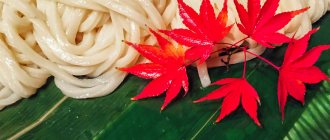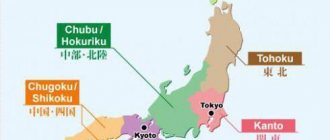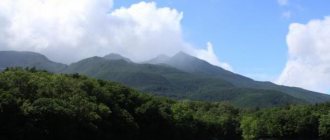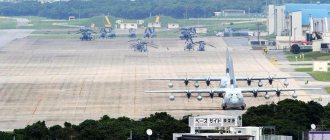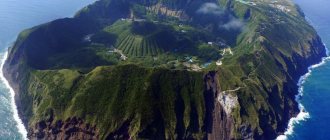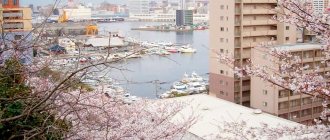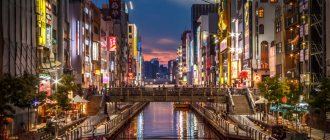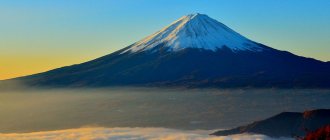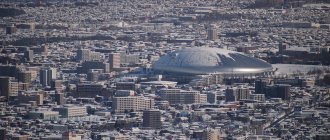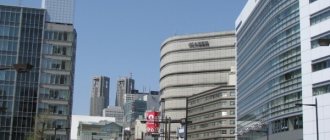Kyushu Island is the third largest island in the Japanese archipelago after Honshu and Hokkaido. Its area is more than forty thousand square kilometers. The island is located in the south and lies in the subtropical climate zone. The mountainous terrain with active volcanoes attracts trekking enthusiasts here. And the hot springs are for those who want to soak themselves and at the same time heal. There is an opinion that the entire Japanese civilization originated in Kyushu. Whether it is true or not is difficult to say, but it was from this island that contacts between the Land of the Rising Sun and the outside world began. On ancient Russian maps, Kyushu was designated as Kiu-Siu or Kiu-Shiu. It is separated from the main Japanese island of Honshu by the Shimonoseki Strait. A bridge and numerous Kammon tunnels (railway, road and pedestrian) are built across this water barrier. In this article we will talk about the nature and attractions of the island of Kyushu. It is rightly considered a famous tourist region.
Where is Kyushu Island
This piece of land is located closer to the coast of South Korea. Therefore, Kyushu became the flagship of contact with Western civilizations after so many years of isolation. Most likely, ancient people from the mainland also arrived here. Therefore, Kyushu is considered the cradle of Japanese culture. From the west, the island is washed by the East China Sea. On the other side, the Pacific Ocean approaches it. And in the northeast the Inland Sea of Japan splashes. Kyushu Island has a mountainous topography. Only in the northwest are there plains and low hills. The highest point - the extinct paleovolcano Kuju (1788 meters above sea level) - is located almost in the center of the island. The western shores of Kyushu are heavily indented and abound in picturesque bays. The island has coal deposits (Hidzen, Miike, Chikugo), although the mountains are composed of volcanic rocks, shales and granites.
The price of progress
Several times a day, a small catamaran with the characteristic name “Black Diamond” departs from the city port of Nagasaki. In good weather it takes him less than an hour to reach one of the most impressive historical and cultural monuments in this part of the country.
Hashima-1
Photo: IZVESTIA/Alexander Sidorov
“The Japanese leave here more and more sad every year”
Izvestia report from Kunashir Island - about local residents and troubled neighbors
Hashima Island, located about 15 km southwest of Nagasaki, is only 480 m long and 160 m wide. In reality it is just bare rock, devoid of vegetation and fresh water. At the beginning of the 19th century, coal was found here. And in the second half of the same century, during the era commonly called the Meiji restoration, the Mutsubishi company drew attention to these resources and, with all the merciless cynicism of the era of wild capitalism, set about their development. For about a hundred years, thousands of people lived and worked on a tiny patch of land in the middle of a raging sea (typhoons often occur here). For several decades, it was the most densely populated place on earth - more than 5 thousand people huddled on several hundred square meters.
There were houses, shops, schools, hospitals, even swimming pools. And also mines that go hundreds of meters below sea level, wild overcrowding, unsanitary conditions, unbearable working conditions and high mortality. The Japanese lived next to Chinese and Korean prisoners of war, not much different from prisoners of war themselves.
And then it happened that oil beat coal. In 1974, the mines were closed due to low profitability, and the island was deserted literally overnight. Local residents quickly fled to the mainland, abandoning their simple belongings. Exactly 45 years have passed since then. And over the years, the city on a bare rock in the middle of the ocean has turned into a ghost.
unnamed (1)
Photo: IZVESTIA/Alexander Sidorov
unnamed (3)
Photo: IZVESTIA/Alexander Sidorov
unnamed
Photo: IZVESTIA/Alexander Sidorov
For a long time, access to Hashima was completely closed. But they still somehow penetrated here and robbed them on the sly - local artifacts are still in great demand among collectors. Today tourists are brought on the Black Diamond to look at the ruins, but they are not allowed ashore - it is too dangerous, everything is in disrepair and, apparently, forever.
Volcanic efforts: why it’s worth visiting Sakhalin and the Kuril Islands
Why real exoticism is not necessarily palm trees and snow-white sand
In 2015, the rock was recognized as a UNESCO World Heritage Site as a site of the Industrial Revolution of the Meiji period. The decision is quite strange, if not controversial, given the unbearably complex history of this place throughout most of the twentieth century.
Climate of Kyushu
Monsoon plays an important role in shaping weather conditions. Although the island of Kyushu in Japan has a subtropical climate, most rainfall occurs in the summer. The average annual rainfall is three thousand millimeters. The climate of Kyushu is characterized by pronounced altitudinal zones. Thus, in January, on average, the air temperature in the mountains drops to zero, while on the coast the thermometer does not drop below +10 °C. In the hottest month of the year, July, +15 °C is observed at altitude, while at sea it is as much as +26 °C. The winter monsoon often brings typhoons. Warm currents – the Tsushima and Kuroshio currents – play a large role in shaping the climate of Kyushu, especially coastal zones. In the south of the island there are tropical rainforests, dominated by ferns and palm trees. In the rest of the territory of Kyushu, vegetation is subject to altitudinal zonation. Magnolias and camellias grow in the lower tier, pine trees, azaleas, and cryptomerias grow higher, which give way to alpine meadows.
Economic region of Kyushu
The area includes the entire island of Kyushu and almost one and a half thousand adjacent islands (Tsushima, Goto, Hirado, etc.). The surface of the island is mountainous, the mountains are low, covered with forest (they occupy 2/3 of the territory). The region includes seven prefectures, forming two subdistricts - Northern Kyushu (Fukuoka, Saga, Nagasaki, Kumamoto, Oita prefectures) and Southern Kyushu (Miyazaki, Kagoshima prefectures). The north of the island is economically more developed than the south. Fukuoka Prefecture and the Kitakyushu Industrial Zone stand out.
GRP 2009: 8.75% of GDP (44.201 trillion yen); population 2009: 13.222 million people. (10.4% of the country's population). Most of the national income generated in the Kyushu region comes from the north of the island. The predominant share of this income comes from the manufacturing industry, followed by construction, transport and communications. The region ranks first among other regions of Japan in terms of the share of extractive industries in national income, although this share itself is negligible (less than 1%). The population is distributed very unevenly - more than 3/4 is concentrated in the north. The millionaire cities are Kitakyushu (1 million people) and Fukuoka (1,302 thousand people). In terms of GRP size and the number of employed population, the region ranks fourth after Kanto, Kinki and Tokai.
The mining industry of the region is represented by the mining of coal (about 40% of national production), tin (about 20%), lead-zinc ores, as well as gold (almost 30%) and silver (10%). The region has a developed electric power industry (several large thermal power plants and more than a hundred small hydroelectric power plants), accounting for about 7% of Japan's total electric power capacity. Almost all large thermal power plants are located in the north, and hydroelectric power plants are in Kumamoto and Miyazaki prefectures.
The area is distinguished by its developed agro-industrial complex. In terms of agricultural production, it ranks second after Kanto. The area produces a significant amount of rice (northern Kyushu), wheat, barley, vegetables and fruits. In the prefectures of Kagoshima, Miyazaki, and Kumamoto there are large herds of cattle. The area produces about 20% of its meat and eggs and about a tenth of its milk. The region occupies an even more important position in the field of fishing. Kyushu is completely self-sufficient in food, and part of it goes to other areas.
Among the manufacturing industries, mechanical engineering ranks first, accounting for over 1/5 of products by value. The dominant position in it is occupied by machine tools, means of transport and industrial equipment. Most of the factories producing these products are located in Fukuoka Prefecture, which accounts for up to 40% of its total volume. There are almost two thousand manufacturing plants, employing about 60 thousand people. Shipbuilding dominates the structure of transport engineering. Half of the ships are produced in Nagasaki Prefecture (shipyards in the cities of Nagasaki and Sasebo). The share of shipbuilding in mechanical engineering is approximately 1/3. An important place in the industrial structure of the region is occupied by enterprises of the chemical and metallurgical industries, as well as metalworking.
The Kyushu region is divided into several territorial production units, the largest of which is the Kitakyushu industrial zone (Fukuoka, Saga, Oita prefectures). There are also several industrial units, incl. Oita - Usuki - Saiki (Oita Prefecture); Kumamoto - Uto - Yatsushiro (Kumamoto Prefecture); Nagasaki - Isahaya - Omura (Nagasaki Prefecture); Nobeoka - Hyuga (Miyazaki Prefecture); Sasebo - Imahari (Nagasaki and Saga prefectures); Omuta - Arao (Fukuoka and Kumamoto prefectures). The basis of specialization of all nodes, except for the Omuta - Arao node, is formed by the mechanical engineering industries. The Omuta-Arao junction is dominated by non-ferrous metallurgy and the chemical industry.
The area has a developed transport system. The islands of Kyusi and Honshu are connected by the Kammon underwater road and rail tunnel. In March 2011, the Kyushu Shinkansen
, connecting Hakata and Kagoshima-Chuo stations. In March 2004, it partially operated between Shin-Yatsushiro and Kagoshima-Chuo stations, but to cross the island it took more than two hours, now - 1 hour 19 minutes, and to get from Kagoshima to Osaka - 3 hours 45 min. instead of 5 hours.
Fukuoka. The economy has an industrial-agrarian character. Here is one of the largest territorial production complexes in the country - the Kitakyushu Industrial Zone, where 40% of the Kyushu economy is concentrated. The capital Fukuoka accounts for more than 50% of the prefecture's GRP. 22.4% is the share of the municipality of Kitakyushu, formed in 1963 by the merger of seven cities on the shores of the Kammon Strait, including the city of Yawata, famous for its steel mills, and the shipbuilding city of Moji.
Historically, it was the center of coal mining (completely discontinued) and ferrous metallurgy (Sumitomo). Currently, the automotive industry, the production of semiconductors, steel and alloys, metalworking and mechanical engineering are developed. Fukuoka is the “homeland” of the Bridgestone corporations (there are now many rubber industry enterprises of other companies in Kurume) and the Best Denki consumer electronics chain. The Mitsui group “made” the city of Omuta the center of the chemical industry, where in recent years environmentally-oriented production has been actively developing - the recycling of industrial waste.
In 2011, Fukuoka was awarded the title of "Social Business City", meaning that the city's social entrepreneurship should be primarily aimed at helping earthquake victims and eliminating the consequences of this devastating natural disaster.
The prefecture's traditional products include local Hakata Ori silk fabrics, which have been produced for 750 years, and Hakata Ningyo clay toys. These silk fabrics are made using special Chinese technology; the monopoly right to produce them belonged to the Kuroda clan. Clay toys have been produced since 1601; they were made from the same clay that was used to make bricks for the walls of Kuroda Castle. These figurines depict participants in the Kabuki theater and the local Hakata dontaku festival.
Kumamoto
. Quite developed agriculture (No. 1 in Japan for the cultivation of tomatoes, leaf tobacco; No. 2 for the production of watermelons, eggplants; No. 3 for melons and strawberries). The Kumamoto-Uto-Yatsushiro industrial hub specializes in the electrical and electronics industry, industrial engineering, machine tool building, and the chemical industry. The prefecture is home to an automobile industry and, since 2007, a solar cell plant called Honda Soltec.
Among the tourist attractions, in addition to Kumamoto Castle and Suizenji Park, the stone aqueduct deserves special mention.
Kagoshima. In terms of agricultural production volumes, it is the fourth prefecture in Japan (and No. 1 in Kyushu). Absolute brands are “satsuma imo” (yam, which comes from the first potato brought by the Dutch to Japan through the province of Satsuma - now Kagoshima Prefecture) and green tea, which bears the name of the prefecture. Local shochu (strong, low-grade sake) is no less famous, and 80% of Tokyo residents, when mentioning Kagoshima, associate the prefecture with pig farming - there are up to 1.4 million animals here (excluding decorative mini-pigs). Eel (No. 1 in Japan) and skipjack tuna are caught.
Trading capital has traditionally played a vital role in the region's economy. A powerful contribution to the development of the electronics industry in the prefecture was made by the placement in the small towns of Kirishima, Kokubu, etc., which now form the Kokubu technopolis, of enterprises owned by the Kyosera corporation, Sony Semicondakta, and others. It is not only the low cost of land and tax incentives and labor availability: manufacturers of silicon-based integrated circuits were attracted by the especially pure water filtered through the lava of the Sakurajima volcano.
Recently, the scientific and production complex of space research and technology has received special development: the Japan Aerospace Agency (JAXA) has located its institutions here, including the Tanegashima Space Center and the Uchinoura Space Center.
Oita. The prefecture's agriculture is famous for the cultivation of citrus fruits of the kabosu
, dried
shiitake
, production of 80% Japanese saffron (recognized by many parameters as the best in the world), national leadership in the production of cultivated bamboo of the
madake
. The prefecture is the hottest place in Japan (in terms of geothermal power) and the second in the world (after Yellowstone Park in the USA). Oita is also the No. 1 prefecture in Japan for limestone mining.
In the structure of the prefecture's GRP, the share of the secondary sector is unusually high for modern Japan (almost 37% in the early 2000s). During the period of high rates of economic growth, the Oita Rinkai industrial hub was formed, covering the city in addition to the capital. Usuki, Saiki and others. In the early 1980s. The structure of the industrial production of the hub was dominated by ferrous metallurgy, oil and coal refining and shipbuilding. Currently, electrical and transport engineering is developing at the fastest pace, thanks to the location of factories of such corporations as Canon, NEC, etc. In 2004, an automobile manufacturer located its production in Nakatsu, complementing the existing one in the neighboring prefecture. Fukuoka automotive cluster (Kanda city). A joint venture between the Sony and Toshiba corporations, TS Semicondakta in Oita, is involved in the production of the famous PS3 game consoles.
The prefecture has the highest level of energy self-sufficiency in Japan (about 25%) - largely due to geothermal energy. Isson-ippin” movement arose and received not only all-Japanese but also international recognition
” (“one village - one product”), which allowed Oita Prefecture to enter into a variety of foreign economic relations.
Nagasaki. Since the territory of the prefecture is dominated by highly dissected mountainous and hilly terrain, and the coastline is intensively indented, the area of cultivable land is extremely limited; Rice, barley, wheat, and vegetables are mainly cultivated in the coastal lowlands; on the terraced slopes there are tea bushes and mulberry plantations. The main agricultural crops are potatoes and sweet potatoes. Livestock is raised on the islands of Hiradoshima and Goto. Pearls and seaweed are mined and processed.
Industry is concentrated mainly in the cities. Nagasaki and Sasebo (second after Nagasaki, the port city of Sasebo is primarily a naval base for both the Japanese Self-Defense Force and the US Navy). When Japan was closed to other countries for a long period of time (starting from the 1600s until the mid-19th century), Nagasaki was the only city where foreign trade was allowed, and which was for the Japanese a “window to Europe” - precisely through the island Dejima, within the Nagasaki waters, brought Western know-how to the archipelago, as well as various overseas curiosities from China, Southeast Asia, India and Arab countries. Today, Nagasaki is actively involved in international trade, which began with the emergence of the prefecture's main industry, shipbuilding. The prefecture is home to a large number of small and medium-sized companies that support the shipbuilding industry. Many of these companies have developed technologies to serve the shipbuilding industry and have gained worldwide recognition in areas such as industrial equipment for manufacturing and metal processing.
The main industries (except for shipbuilding, which remains the basis of the prefecture's transport engineering industry) are metallurgy, glass and ceramics, and food (fish canning, etc.) industries. Waste processing technologies, water purification systems, and wind energy generation are considered promising areas of industrial development in the prefecture. The biotech sector mainly focuses on environmental research. Nagasaki promises to become a region with highly developed wind energy, this is facilitated by the advantageous geographical location of the prefecture - a long coastline and numerous islands.
Nagasaki Prefecture has a very advantageous location and has easy access to the markets of China, Korea and Southeast Asia. There are regular direct flights to Shanghai and Seoul, and sea routes allow transportation between Nagasaki and Busan.
Since the 1970s. There is a rapid decline in the population of the prefecture, which by the 2000s led, in particular, to such consequences as the actual economic “relocation” of the islands of Tsushima and Iki into the orbit of gravity of the prefecture. Fukuoka. Tourist sites are very diverse - these are, first of all, the Peace Park (memorial of the atomic bombing of 08/09/1945), the Dejima Dutch Factory Museum, examples of European architecture, the castle in Shimabara, etc.
Miyazaki. The prefecture is proud of its livestock products and vegetable greenhouse farms (second to Gunma Prefecture in annual cucumber harvests, Miyazaki Prefecture is No. 1 in Japan in the winter-spring period). Autumn daikon harvests are the largest in Japan (despite the fact that the prefecture is only third in the country in terms of area sown with this crop).
The Nobeoka-Hyuga industrial hub on the northeastern coast of the prefecture has long had a pronounced production specialization - the chemical industry, mainly represented by large ones (in the 1980s, their number reached 8), but since then almost all of the company's production facilities were transferred abroad, production volumes of the chemical industry in the region fell significantly. Another promising area of industrial development is semiconductors, solar panels, and pharmaceutical products, for which factors such as proximity to the airport and the availability of clean water turned out to be important.
The tourism boom of the 1960s (then the prefecture was the most popular honeymoon destination for newlyweds) was interrupted in the early 1970s. when the niche of “southern charm” was occupied by Okinawa (thanks to the special government policy of tax and subsidy incentives for this prefecture, the price competitiveness of tourism services of other prefectures decreased significantly). Compensate for the loss of the preference market. Miyazaki is trying through sports tourism - the infrastructure for professional baseball and surfing has been created here.
Saga. Saga Prefecture has held the national championship in terms of agricultural intensity for more than twenty years: despite the fact that only 24% of the prefecture’s territory is used for crop production, the arable land utilization rate here is 133% - the highest figure in Japan (due to the prevalence of two harvests per year) . In the 1930-60s. The prefecture also demonstrated record levels of efficiency in rice production throughout Japan (it was the first to electrify and mechanize it). In recent decades, “rice specialization” has given way to new products - now it is livestock farming, vegetable growing and fruit growing (primarily, local beef is famous (black bulls "Saga Ushi", onions, strawberries, greenhouse tangerines). What remains is the national championship in the production of mochigome
– sticky rice for making
mochi
.
Being the fourth largest producer of legumes in the country, the prefecture excels in the production of yokan
- “Japanese marmalade” (a traditional sweet made from boiled and mashed beans).
Among the prefecture's famous products is Saga Nishiki brocade, but perhaps the most branded product is ceramics. From the end of the 16th to the beginning of the 17th century, when entire villages of potters were forcibly brought from Korea, in the region of the city. Karatsu, Arita, Imari formed a center for the production of porcelain and ceramics of famous styles (“Arita-yaki”, “Karatsu-yaki”), which have long been export items (especially “Imari-yaki”). The modern ceramic industry is also highly developed. The city of Imari is part of the same industrial hub with the city of Sasebo (Nagasaki Prefecture), specializing in ship repair and shipbuilding, semiconductor production, and food industry. A significant part of the pref. Saga is actually part of the Kitakyushu industrial zone, being integrated into industrial relations with enterprises in the city of Kurume (Fukuoka Prefecture).
Conclusions on the topic:
1. Kyushu is a rapidly developing segment of the Pacific Industrial Belt, where many high-tech industries have relocated over the past decades.
2. Historical factors played a significant role in the development of almost every prefecture in the region, determining the peculiarities of their economic specialization.
Okinawa
The scope of this southernmost economic region is determined by the territory of Okinawa Prefecture. It includes three groups of islands - Okinawa, Yaeyama, Miyako between Japan and Taiwan itself. Prefectural GRP (2014): 4.1748 trillion yen (35th in the country); population 1.421 million people. (25th in the country); per capita income 2.129 million yen (last place among 47 prefectures).
The islands of this area are separated by considerable distances from each other and from the key economic and political centers of Japan. To this day, American military bases have remained in Okinawa, occupying up to 12% of the area's territory, and in some cases preventing the effective use of natural resources. Okinawa's relatively weak economic development is due to the long American occupation after the war. Before World War II, Okinawans lived primarily by farming and fishing. Up to 70% of the labor force was employed in growing, harvesting and processing sugar cane.
Judging by the structure of the prefecture's national income, the service sector has received the greatest development here, while construction, transport, manufacturing industries and even agriculture and marine fishing lag far behind the corresponding industries in other parts of the country. With an economy based on sugarcane, pineapple and fishing, Okinawa has always been the country's poorest prefecture, but tourism has helped it significantly. Large Japanese corporations began actively investing in the prefecture in the late 1970s, turning pineapple plantations into golf courses and erecting reinforced concrete hotel buildings on the beaches.
Okinawa has huge storage tanks for oil coming from the Persian Gulf countries. From Okinawa, crude oil is transported to various points in Japan proper. Several oil refineries operate in Okinawa based on imported oil. Okinawa's contribution to national food production is negligible, despite good agro-climatic conditions. The transport system is also poorly developed, reflecting the general weakness of the economy. The distance of hundreds and sometimes thousands of kilometers from the main Japanese islands determined the paramount importance of maritime transport and aviation. Naha International Airport has acquired the status of an intermediate point for passenger traffic between Tokyo, Osaka and the countries of Southeast Asia and Oceania. The only 3,000 m long runway serves 150 flights daily. Plans were announced for the construction of a second lane, which will be put into operation by 2015.
A fertile climate and waters rich in fish and other marine life, corals of all colors and the rarest black pearls mined only here - this is, perhaps, the main treasure of Okinawa Prefecture. The Okinawa Oceanarium ranks second in size and volume among objects of this type in the world. It was opened in 2002, but by 2010 the number of its visitors numbered more than 20 million people.
The economic backwardness of the Okinawa region, due to its geographical remoteness and history of integration into the Japanese economy, forces the country's government to pursue a special policy to promote the development of the region, the key industry of which is tourism.
Seismological situation
In addition to the extinct Kuju volcano, the island has no shortage of active ones. The most active is Aso, with a height of 1592 meters. The capricious and unpredictable Sakurajima and Kirishima are not far behind him. The entire island is considered an earthquake zone. Not long ago, Kyushu hit the top news. In mid-April this year, a major earthquake occurred in Japan on the island of Kyushu. Its epicenter, with a magnitude of eight, was located near the city of Kumamoto. A series of aftershocks, which lasted a whole week, claimed forty-four human lives. More than a thousand more people were injured. Due to landslides and destruction, more than one hundred thousand people had to be evacuated. But such a dangerous seismological situation also has another, attractive side. The uncooling depths of the earth give rise to thermal springs. Aso, the most active volcano on the island of Kyushu, provides a stable income for the Beppu spa resort.
Kuju Flower Park (Oita)
Do you love photography and want to get hundreds of likes on your Instagram? Then Kuju is the perfect place for you. It's no joke, more than three million flowers grow here!
The set of colors directly depends on the season. But there are always about 500 varieties. And if you get to the park during the flowering period, your head will go spinning not only from the beauty, but also from the aromas. Just remember to make sure in advance that you are not allergic to plants or their pollen.
How to get to Kyushu
If you're arriving on the island by air, you'll likely be picked up at Fukuoka International Airport. This hub is connected by many flights to Europe, Asia and the rest of Japan. Airports in other cities in Kyushu offer a smaller range of destinations. Mostly from them you can fly to Shanghai and Seoul. Fukuoka can be reached from South Korea by ferry. The Sanyo Shinkansen high-speed railway starts in Osaka and runs to Kagoshima via Fukuoka. Trains also stop at Kokura and Hakata. A trip on such high-speed trains is equivalent to a tourist attraction: from Tokyo to Fukuoka the entire journey will take only less than six hours. You can arrive to the island through the tunnel by bus. Willer Express sends its cars to Kyushu daily from Tokyo, Osaka and Nagoya.
The three most famous festivals in Kyushu are:
- Nagasaka Kunti in the city of the same name. A vibrant celebration of food, fun and Nagsaki's diverse cultural past and present, which has been celebrated for 400 years.
- Hakata Gion Yamakasa Festival in Fukuoka. One of the most exciting festivals in Japan. Men in traditional costumes parade through the city streets with various yamakasa - traditional portable temples in different variations, decorated with lanterns.
- International Balloon Fiesta in Saga. A sports festival of hot air balloons, the finale of which is accompanied by fireworks and a small show. An incredible sight when huge balloons soar into the sky. You can participate yourself if you have time to sign up.
Sights of Nagasaki
This port on the island of Kyushu is also one of the main cities in Japan. It is located in the west, on the shores of Nagasaki Bay. There are so many attractions in this city that we can only list them. A must-see is the Peace Park with the Atomic Bomb Museum and the memorial hall for the victims of the American bombing. Puccini created the opera Madama Butterfly based on the true story of Thomas Glover's love for the daughter of samurai Tsuru Yamamura. There is a garden in Nagasaki where the novel took place. Other attractions in the city include the Suwa and Sanno-jinja temples, the Lessons Cathedral, the monument to the 26 Christian martyrs, Chinatown, the Historical Museum, the ghost island of Hashima, the monastery complexes of Fukusai, Sofuku and Kofuku-ji, and Oura Church.
Things to do in Kyushu
The mountainous landscape with active volcanoes is one of the attractive attractions of the island. One of the items on the “must do” list is a trip on an ancient train with three carriages, “Hitoyoshi-go,” which runs from the designated point to Kumamoto through the picturesque places of the Kuma River valley. An excursion to the Shimabara Peninsula will be interesting. There was an uprising here in the seventeenth century, as a result of which all of Japan became isolated from the rest of the world for two centuries. Only Dutch and Chinese merchants were allowed to come to Shimabara, and even then under a very limited quota. The Land of the Rising Sun opened its ports to foreigners only in 1854. A trip to Kyushu Island would not be complete without visiting the surrounding area of Aso. This volcano has the world's largest caldera. Several safe walking routes have been developed with observation platforms that offer stunning views of the “lunar landscape” of the Aso lava fields. A more extreme trip would be to Kagoshima. Volcanic ash from Sakurajima falls on the roofs of this city as often as rain.
Transport Kyushu
Kyushu Shinkansen trains take anyone from Fukuoka to Kagoshima in just 1 hour 20 minutes. And Hisatsu Line trains run from Kumamoto to Hayato.
In April 2009, on the section between Kumamoto and Hitoyoshi stations, the operation of the Hitoyoshi-go steam locomotive was resumed, pulling 3 passenger cars through the most picturesque places along the Kuma River.
JR Kyushu passes
The Jayaru Kyushu Pass (one of the ones that operates in Kyushu) is only valid for tourists arriving on tourist visas and provides unlimited use on the Jayaru Kyushu Lines, including the Kyushu Shinkansen, but is not valid on the Sanyo Lines. Shinkansen to Hakata. A three-day pass valid for travel around the Northern Kyushu region will cost 8,500 JPY, a five-day pass will cost 10,000 JPY. A three-day pass, valid for all areas of Kyushu, costs 15,000 JPY, a five-day pass costs 18,000 JPY.
One of the most breathtaking landscapes in Kyushu is perhaps that of Aso, Japan's largest active volcano with one of the world's largest calderas.
Buses
Bus routes cover parts of the road that are not covered by trains, but their traffic is usually very limited. There is also a network of "highway" buses, similar to the railway network. They offer "SUNQ" passes, valid for 3-4 days for an unlimited number of trips: a 4-day pass, valid in all areas of Kyushu, will cost 14,000 JPY, for 3 days - 10,000 JPY; A 3-day pass valid in the Northern Kyushu area will cost JPY 8,000.
Kyushu Island attractions
Fukuoka is an eternally young and vibrant city. Nightclubs, high-tech museums and traditional Japanese culture live side by side here. Here you can go to a performance at the Kabuki and Noh theaters, as well as interact with the latest robot designs in Robosquare. It's also good to get a bird's eye view of Fukuoka by climbing the 234-meter tower. Fujisaki Shrine, Suizenji Castle and Garden are must-sees in Kumamotu. Kyushu is famous throughout Japan for its thermal springs. To soak in them, you should go to the Beppu resort. The most famous is the complex of hot springs under the ominous name “Nine Hells”. If mountain trekking is your thing, head to the Kirishima Southern Volcanic Range. Well, if you are a surfing fan, go to the beaches of Miyazaki.
Udo Shrine (Miyazaki)
The Udo Temple was built in a cave overlooking the stormy ocean waters. According to legends, one of the founders of the temple was Jimmu, the first Japanese emperor.
This is one of those attractions that is worth setting aside a few hours to visit. In addition to contemplating the ocean and architectural forms, here you can simply think about the eternal. And if you want to “become mischievous,” pick up a handful of stones and try to hit the rope target placed on the rock. It is believed that hitting the target can bring good luck.
What to try and buy as a souvenir
The island of Kyushu is famous for its cuisine. In Kumamoto, you need to try the signature dish, karashirenkon. It is a lotus stem stuffed with mustard seeds and fried in a wheat and soy coating. On the island of Kyushu, as in Catalonia, black pigs are raised. Therefore, the local specialty is the Japanese equivalent of jamon - tonkotsu ramen. Basashi is raw horse meat in soy sauce, eaten with ginger. A variety of tropical fruits and sugar cane are grown on the southern island of Kyushu. For drinks, you should try shochu. This region is famous for its pottery making. Cookware should be purchased from Arita and Karatsu.
Food in Kyushu
- Ikinari Dango in Kumamoto - steamed bun with bean jam and sweet potato.
- Mentaiko in Fukuoka - cod roe marinated in red pepper. The dish came to Japan from Korea. It is also worth trying pizza and pasta with the addition of mentaiko.
- Tonkatsu in Kagoshima - juicy pork cutlets in a crispy breadcrumb crust. It is believed that this is the most delicious tonkatsu, because the best kurubutu pork is produced in Kagoshima.
- Chicken nanban in Miyazaki - fried local chicken pre-marinated in sweet and spicy vinegar, topped with tartar sauce. The dish originally appeared in one of the Miyazaki family restaurants. It was so delicious that it quickly became a prefectural delicacy.
- Sasebo Burger in Nagasaki - huge burgers made from local ingredients. They serve many different types of this burger, but most often it is a burger with bacon and egg, or with a huge piece of local chicken.
- Champon in Nagasaki is a noodle dish with meat and vegetables in broth. Unlike traditional ramen, where the noodles are cooked separately from the broth, the noodles for Champon are cooked directly in the broth.
